Related Link:
Restoring Coral Reefs in Hawaii
On June 7, 2023, Tampa Bay news reporters trekked to the Sunshine Skyway bridge for a Florida Dept. of Transportation press conference that would explain the mystery behind the hundreds of curiously shaped concrete structures lining nearly the entire length of the span’s mile-plus-long south fishing pier access road.
Lined up neatly along the water line, like soldiers in near-perfect formation, the more than 840 large, three-sided pyramid-shaped concrete structures—differing only in their varying heights of 8.5 ft to 10 ft—stand ready to be deployed.
The structures—an engineered product known by their trademarked moniker of WAD, for wave attenuation device—represent FDOT’s first use of what has proven to be a faster, better and cheaper method of constructing breakwaters. Moreover, as a byproduct of their design, the WADs simultaneously create reefs and replenish shorelines, including Florida beaches and Louisiana marshland.
Nevertheless, despite their roughly 20 years of being used in various locations around the country, FDOT’s use of the WADs for the $6.3-million design-build Skyway wave attenuation project marks the first time any state- or federal-level agency in the U.S. has deployed them.
At the press event, Brent Setchell, FDOT District 1 drainage design engineer, explained how the agency opted for the new approach after first examining traditional methods of breakwater construction.
“We looked first at traditional riprap or large boulders” to build the breakwaters, but “due to the deep water that’s located here, as well as the large footprint that would have been required and significant costs,” the WADs won out, he said.
With sea levels along U.S. coastlines poised to rise an average of 10-12 in. over the next 30 years, according to the National Oceanic and Atmospheric Administration, projects to protect and restore shorelines are becoming more prevalent and top-of-mind.
But this contract was more than just an experimental trial run. Instead, FDOT had an urgent problem to fix—the recently repaired seawall running along the south fishing pier’s access road was cracking all along its length and width.
The specific threats of sea-level rise upon the broader Tampa Bay area loom, too. For example, a July 2022 report delivered to FDOT by INTERA Corp. warned that “future sea level rise in the project area could adversely affect foundation scour, vertical clearances and wave attack on upland infrastructure.”

A previous installment of WADs shows the degree to which the system can promote the growth of marine life.
Photo courtesy Living Shoreline Solutions
FDOT’s request for proposals mandated construction of two breakwaters—one 10.5 ft tall and 1,180 linear ft in length, and a second 8.5 ft tall and 1,512 long. The structures would be located in two separate arrays approximately 200 ft from shore, and would need to rise to a minimum elevation of approximately 3 ft above the waterline. In all, the two breakwaters would require approximately 844 WADs, 484 of the 8.5-ft-tall units, and 360 of the 10.5-ft-tall structures.

The WADs are placed and precisely positioned in two rows in order to both attenuate wave energy and foster biomass growth within each
unit’s interior.
Graphic courtesy Living Shoreline Solutions
Another mandate required the two breakwaters to collectively foster nearly six acres of seagrass growth, thereby earning FDOT mitigation credits for use on future projects.
Part of FDOT’s main performance requirements—which related to such items as the structure’s stability, “resisting subsidence, overtopping or shifting” and minimizing scour—called for the breakwater to attenuate at least 70% of wave energy hitting the existing seawall.
The traditional methods of constructing breakwaters, such as with boulders and riprap, often don’t reach that bar, says Scott Bartkowski, CEO of Living Shoreline Solutions Inc. (LSSI) and inventor of the WAD. Bartkowski adds that the WAD devices generally achieve a minimum of 80% wave attenuation, and often top 90%.
Compared to more inland sections of Tampa Bay, for example, the Skyway project’s proximity to the Gulf of Mexico makes the site “kind of a unique location where you have this high exposure to wave energy,” says FDOT’s Setchell.
Models generated by University of South Florida coastal geology professor Ping Wang assessing the WADs’ effectiveness within the Tampa Bay site’s conditions back Bartkowski’s claim, noting that “the present design of the WADs array would result in wave-height reduction of at least 90% under all conditions, including cases with significant storm surge.”
The design-build team of contractor Vecellio & Grogan and engineer TranSystems, with LSSI as a subcontractor, proved to be the lone submitter to the RFP. AECOM is serving as the project’s construction engineering and inspection firm. The project was awarded in 2022, with construction start approved this past May. Placement of the WADs began in June.
In addition to being more effective, the WADs-built breakwater proved less expensive and quicker to construct. A traditional breakwater with riprap, which “was going to have a bigger footprint,” and proved “cost-prohibitive” compared to the WADs, says TranSystems’ John Hartland, the project’s engineer of record.
A main factor in determining the WAD arrays’ specific positioning and length was making sure “we’re providing enough acreage to meet that criteria for the new seagrass,” says Hartland.

Precise positioning of the WAD arrays was determined by the need to boost seagrass growth.
Photo by Scott Judy
How the WADs Work
The 10.5-ft-tall, 13,000-lb WADs included on the Sunshine Skyway project are the largest LSSI has ever delivered, though the firm’s design for a 15-ft-tall WAD is a component of a locally preferred plan for the Army Corps of Engineers New England District’s still-pending Camp Ellis Beach Shore Damage Mitigation Project in Saco, Maine.
So far, LSSI’s WADs mostly have been utilized by municipal governments, environmental groups, such as the Audubon Society, and private individuals, mostly on a smaller scale. One exception is a Louisiana project where more than 6,000 WADs were deployed in an effort to restore coastal shoreline.
LSSI designs its WADs to meet specific site needs, but all incorporate a pyramid shape. The choice came from Bartkowski’s experience diving and seeing too many artificial reefs composed of old cars or other waste items that would ultimately become structurally unsound and end up causing damage to marine life.

Photo by Scott Judy

Photo courtesy Florida Dept. of Transportation
All 844 of the WADs are cast on site, using custom-built concrete forming systems. Above right, triangular openings on each face of the WADs will assist in controlling wave energy impacting the breakwater.
“That stuff is not durable, it’s not productive and it’s not going to produce marine biomass,” he says. With an engineering degree in aeronautical and aerospace engineering, the retired Navy pilot sought to design a reef system that would remain stable.
Eyeing pyramids as one of the most stable shapes, Bartkowski and company eventually settled on a three-sided pyramid as its base design. The company then focused on designing something “that was not a rock breakwater that would refract wave energy, but something that would eventually become a natural reef.”


Placement of the WAD units, aligned in two curving arrays, required a crew of three, including a crane operator and two other workers assisting with placement onto the barge and into each unit’s precise location.
Photos courtesy Vecellio & Grogan
The company uses a standard concrete mix design without any rebar, instead opting for approximately 3 lb of fiber mesh per WAD. Once it finalizes the design, the units are site-cast. Bartkowski says the structures usually reach over 9,000 psi at 28 days. The 8.5-ft tall units weigh 8,500 lb, while the larger WADs weigh 13,000 lb.
Important to the WADs’ performance are the triangle-shaped openings located on each face of the unit. Each opening is subtly tapered so that the inside is either slightly smaller or slightly larger than the outside opening. This is done to control the wave energy by either increasing or decreasing its velocity at various points, thereby manipulating the flow of incoming micronutrients and causing them to drop to the bottom of the hollow structure’s interior. In turn, Bartkowski says, this “feeds marine biomass, which allows fish to have shelter inside the structure.”
Placing the units into their specifically patterned arrays was next. A crew of three Vecellio & Grogan workers installed the WADs, with two assisting with loading the units onto a barge and helping the crane operator set them precisely into place.
When the crew can avoid weather-related interruptions, they’ve been able to place between 25 and 30 WADs per day, says the contractor. Once all of the WADs are placed—scheduled by the end of July or early August—the only remaining step will be the placement of riprap along each array’s seaward side and along each edge. FDOT is hopeful the Sunshine Skyway breakwaters perform as expected, with Setchell noting that, if they do, the WADs will be considered for future projects.
Adds Setchell, “I’m really looking forward to snorkeling it and seeing all the fish and marine life.”
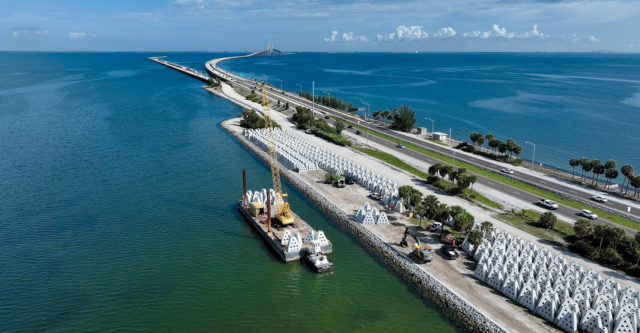



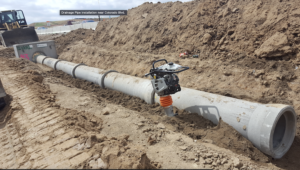
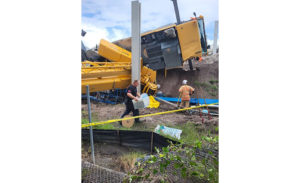
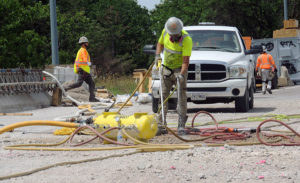
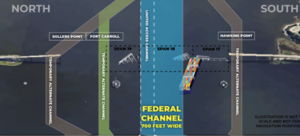

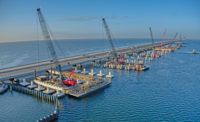

Post a comment to this article
Report Abusive Comment